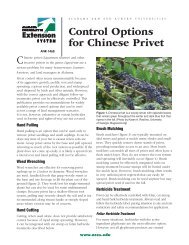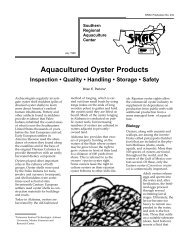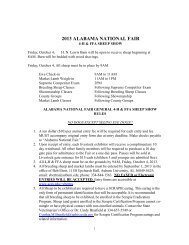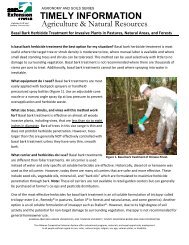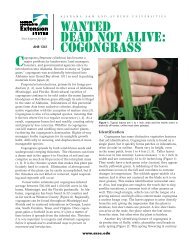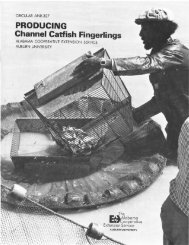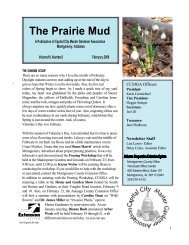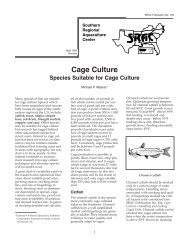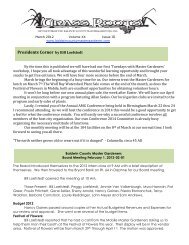Subterrranean Termites - Termitas Subterráneas
Subterrranean Termites - Termitas Subterráneas
Subterrranean Termites - Termitas Subterráneas
Create successful ePaper yourself
Turn your PDF publications into a flip-book with our unique Google optimized e-Paper software.
UNA VIDA<br />
MEJOR<br />
Subterranean <strong>Termites</strong><br />
<strong>Termitas</strong> <strong>Subterráneas</strong><br />
Subterranean termites are the most damaging<br />
insects of wood. Their presence is hard to notice<br />
and damage usually is found before the termites<br />
are seen. Prevent infestations because if they<br />
occur they will almost always need professional<br />
pest control service.<br />
Signs of Infestation<br />
Generally, the first sign of infestation is<br />
the presence of swarming termites on the<br />
window or near indoor light. If they are<br />
found inside the house, it almost always<br />
means that they have infested. Other<br />
signs that may be found are termite<br />
wings on window sills or in cobwebs,<br />
and shelter tubes, which are tunnels<br />
constructed by the termites from soil<br />
or wood and debris.<br />
Usually, wood damage is not found at<br />
first, but when it is found it definitely<br />
reveals a termite infestation. Anywhere<br />
wood touches soil is a possible entry into a<br />
home for termites. Examine wood which<br />
sounds dull or hollow when struck by a<br />
screwdriver or hammer. Inspect suspected<br />
areas with a sharp, pointed tool such as an ice<br />
pick to find termite galleries or their damage.<br />
Las termitas subterráneas son los insectos más<br />
destructivos de madera. Su presencia no se nota<br />
fácilmente y el daño comúnmente se hace<br />
evidente antes de que se expongan las termitas.<br />
Prevenga infestaciones, porque si ocurren, casi<br />
siempre se requiere de un tratamiento<br />
profesional para eliminarlas.<br />
Señales de Infestación<br />
Generalmente, la primera señal de<br />
infestación es la presencia de un<br />
enjambre de termitas en una ventana<br />
o alrededor de una luz. Si se<br />
encuentran dentro de la casa, casi<br />
siempre significa que ya han infestado.<br />
Otras señales son: alas de termitas sobre<br />
las repisas de ventanas o en telarañas, y<br />
túneles de refugio que son construidos de<br />
tierra, madera y deshechos por las termitas.<br />
Comúnmente, el daño a la madera no se<br />
ve, pero cuando sí se descubre da a conocer<br />
que existe una infestación de termitas.<br />
Dondequiera que madera esté en contacto con<br />
tierra hay una posible entrada a la casa para las<br />
termitas. Examine la madera que suene sorda o<br />
hueca cuando se golpea con un desarmador o<br />
martillo. Revise las áreas sospechadas con una<br />
Texas Agricultural Extension Service • The Texas A&M University System<br />
Servicio de Extensión Agrícola de Texas • El Sistema de Universidades de Texas A&M
Control<br />
Control measures include reducing the<br />
potential infestation, preventing termite entry,<br />
and applying chemicals for remedial treatment.<br />
Inspection<br />
Inspect thoroughly to determine if there is an<br />
infestation, damage, conditions that could invite<br />
a termite attack, or the need for remedial control<br />
measures. The tools and equipment needed for<br />
an inspection include a flashlight, ice pick or<br />
sharp-pointed screwdriver, ladder, and protective<br />
clothing.<br />
Outdoors<br />
Check the foundation of the house, garage and<br />
other buildings for shelter tubes coming from<br />
the soil. Look closely around porches, connecting<br />
patios, sidewalks, areas near kitchens or<br />
bathrooms and hard-to-see places. Check<br />
for termite infestation or wood decay along window<br />
and door frames and where utility services<br />
enter the house. Also look behind shrubbery or<br />
plants near walls. Pay special attention to areas<br />
where earth and wood meet such as fences, stair<br />
carriages or trellises. Open and check any<br />
exterior electrical meter or fuse box set into<br />
the wall, a common point of infestation.<br />
Indoors<br />
Carefully check all doors, window facings,<br />
baseboards and hardwood flooring. Discoloration<br />
or stains on walls or ceilings may mean that<br />
water is leaking and can decay wood and aid<br />
termite infestation. It is very important to<br />
inspect where plumbing or utility pipes enter<br />
the foundation or flooring. Also examine the<br />
attic for shelter tubes, water leakage, wood rot<br />
or wood damage.<br />
herramienta puntiaguda, tal como un picahielos,<br />
para encontrar las termitas o su daño.<br />
Control<br />
Las medidas de control incluyen: reducir la<br />
posibilidad de infestación, prevenir la entrada<br />
de termitas y remediar con aplicación de<br />
tratamientos químicos.<br />
Inspección<br />
Revise bien para ver si hay una infestación,<br />
daño, condiciones que inviten una invasión de<br />
termitas o si se necesitan tomar medidas de<br />
control. Las herramientas y el equipo necesario<br />
para una inspección incluyen una linterna<br />
eléctrica, picahielos o desarmador puntiagudo,<br />
una escalera y ropa protectora.<br />
Afuera de la casa<br />
Revise el cimiento de la casa, garaje y otros<br />
edificios para ver si hay túneles de refugio que<br />
vienen desde el suelo. Mire bien alrededor de<br />
portales, patios, banquetas, áreas cerca de<br />
cocinas o cuartos de baño y lugares retirados.<br />
Revise los marcos de puertas y ventanas y donde<br />
entran a la casa los servicios de utilidad para<br />
saber si hay una infestación de termitas o<br />
deterioro de madera. También mire detrás de<br />
las plantas cerca de las paredes. Ponga atención<br />
especial a áreas donde tierra y madera se<br />
juntan, tal como cercas, escalones o espalderas.<br />
Abra y revise cualquier caja de fusibles o<br />
medidor colocado en la pared, un lugar común<br />
de infestación.<br />
Adentro de la casa<br />
Revise cuidadosamente todas las puertas,<br />
ventanas, rodapíes y pisos de madera.<br />
Descoloramiento o manchas en las paredes o los<br />
cielos pueden indicar que agua ésta goteando y
Prevention<br />
Many termite problems can be prevented. The<br />
most important thing to do is deny termites<br />
access to food (wood), moisture and shelter.<br />
Follow the suggestions below.<br />
• Have at least a 2-inch clearance between the<br />
house and planter boxes or soil-filled porches.<br />
• Eliminate all wood-to-soil contacts, such as<br />
trellises, fence posts, stair casings and door<br />
facings (they can be put on masonry blocks<br />
or on treated wood).<br />
• Separate shrubbery from the house to help<br />
make it easier to inspect the foundation line.<br />
• Use Wolmanized wood (pressure-treated<br />
wood) so that rain will not rot it.<br />
• Seal openings through the foundation.<br />
• Remove wood scraps or stumps from around<br />
foundations.<br />
• Have at least 12”-18” clearance between floor<br />
beams and the soil underneath.<br />
Chemical Treatment<br />
Termite treatment often requires specialized<br />
equipment. Therefore, it is recommended that<br />
you always use the services of a pest control<br />
operator because he is familiar with<br />
construction principles and practices, has the<br />
necessary equipment and knows about<br />
subterranean termites.<br />
puede pudrir la madera y contribuir a una<br />
infestación de termitas. Es muy importante<br />
revisar las áreas donde entran los tubos de<br />
utilidad al cimiento o piso. También vea el ático<br />
para saber si hay túneles de refugio, filtración de<br />
agua o madera podrida o dañada.<br />
Prevención<br />
Muchos problemas de termitas se pueden<br />
prevenir. Lo más importante es impedir que las<br />
termitas puedan llegar al alimento, es decir la<br />
madera, humedad y refugio. Siga estas<br />
sugerencias.<br />
• tenga por lo menos un espacio de 2 pulgadas<br />
entre la casa y macetas y portales<br />
• elimine todos los lugares donde la madera<br />
toca con tierra tales como espalderas, postes<br />
de cerca, escalones y puertas (se pueden<br />
poner en bloques de albañilería o en madera<br />
tratada)<br />
• separe las macetas y ramaje denso de la casa<br />
para facilitar la inspección de la línea de<br />
cimiento<br />
• use madera tratada para que la lluvia no la<br />
pudra<br />
• cierre aberturas en el cimiento<br />
• quite pedazos de palo o madera de alrededor<br />
de cimientos<br />
• tenga al menos de 12 a 18 pulgadas de<br />
espacio entre las vigas del piso y el suelo<br />
debajo.<br />
Tratamiento Químico<br />
Tratamiento para las termitas casi siempre<br />
requiere equipo especializado. Por lo tanto,<br />
siempre se recomiendan los servicios de un<br />
exterminador porque él conoce las prácticas y<br />
los principios de construcción, tiene el equipo<br />
necesario y conoce las termitas subterráneas.
You may contact your local county Extension<br />
office for more information on how to select a<br />
termite control service.<br />
Adapted from TAEX publication L-1781 Subterranean<br />
<strong>Termites</strong> for your use by Ana A. DeLuna, Extension<br />
Assistant in Communications. Graphic design by Rhonda R.<br />
Kappler.<br />
Una Vida Mejor project activities are supported by a grant<br />
from the W. K. Kellogg Foundation.<br />
Educational programs conducted by the Texas Agricultural<br />
Extension Service serve people of all ages regardless of<br />
socioeconomic level, race, color, sex, religion, handicap, or<br />
national origin.<br />
Usted puede llamar a la oficina de Extensión de<br />
su condado para más información en cuanto a<br />
seleccionar un servicio para el control de<br />
termitas.<br />
Adaptado y traducido de la publicación Subterranean<br />
<strong>Termites</strong> L-1781 del Servicio de Extensión Agrícola de<br />
Texas para su uso por Ana A. DeLuna, Asistente de<br />
Extensión en Comunicaciones. Diseño gráfico por Rhonda R.<br />
Kappler.<br />
Actividades para el proyecto Una Vida Mejor son<br />
patrocinadas por una subvención de la Fundación W. K.<br />
Kellogg.<br />
Los programas educativos dirigidos por el Servicio de<br />
Extensión Agrícola de Texas sirven a personas de todas las<br />
edades sin distinción del nivel socioeconómico, raza, color,<br />
sexo, religión, impedimento u origen nacional



